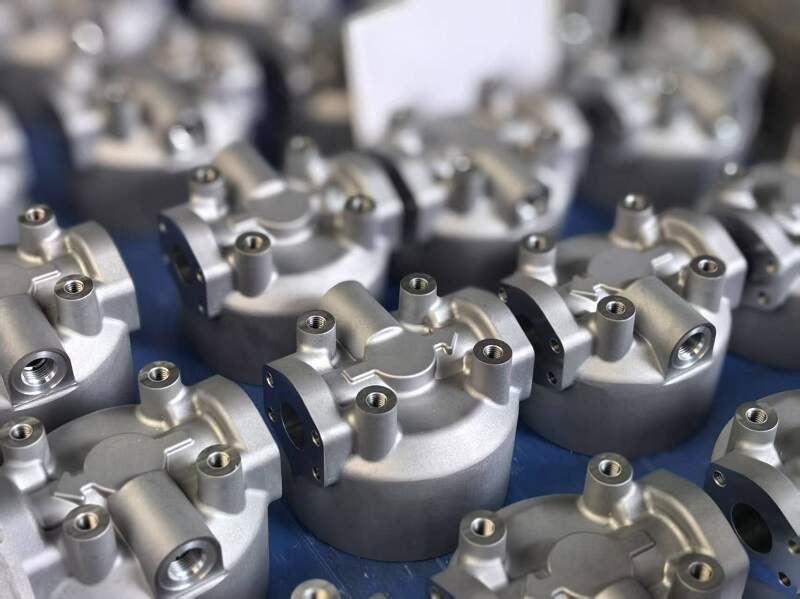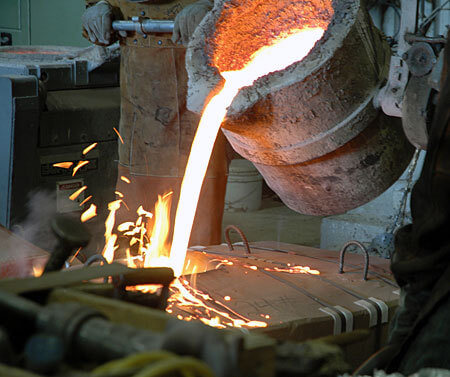Comprehending the Ecological Advantages of Aluminum Factory Techniques
Aluminum factory methods play a necessary duty in advancing sustainability within the production industry. By executing innovative recycling techniques and energy-efficient methods, these strategies substantially reduce waste and carbon footprints. Ingenious casting approaches further improve resource preservation initiatives. As sectors progressively prioritize environmental obligation, understanding the full effect of these methods comes to be essential. What details developments are leading the means in this improvement?
The Duty of Light Weight Aluminum in Sustainable Manufacturing
Although several materials contribute to sustainable manufacturing, light weight aluminum stands apart because of its distinct buildings and recyclability. This lightweight steel is not only resilient however additionally possesses superb rust resistance, making it a perfect option for numerous applications, from automobile to building and construction. Its high strength-to-weight ratio leads to power financial savings during transport and use. Aluminum can be reused forever without losing its intrinsic high qualities, promoting a round economic climate.
The manufacturing process of aluminum has progressed, integrating energy-efficient approaches that lower carbon impacts. By using renewable power resources, makers are progressively lessening the environmental impact connected with aluminum manufacturing. In addition, the usage of recycled light weight aluminum needs substantially less energy compared to removing and fine-tuning key light weight aluminum, causing lower greenhouse gas emissions. As markets seek sustainable options, light weight aluminum's convenience and green features placement it as a pivotal product in the pursuit of greener production methods.
Advanced Recycling Techniques in Aluminum Foundries
Advanced recycling strategies in aluminum shops are revolutionizing the way scrap aluminum is processed and recycled. Innovative methods, such as closed-loop recycling systems, make it possible for factories to reclaim light weight aluminum from production waste and out-of-date items effectively. These systems lessen worldly loss and improve the quality of recycled light weight aluminum, making it a practical choice to key light weight aluminum production.
In addition, advanced arranging innovations, including automated optical sorting and X-ray fluorescence, improve the splitting up of light weight aluminum from various other products, guaranteeing higher purity degrees in recycled results. This precision minimizes contamination, which can endanger the honesty of the end product.
The integration of innovative melting modern technologies, such as induction melting and energy-efficient heaters, enhances the recycling procedure, reducing power intake. Collectively, these innovations add to an extra sustainable aluminum sector by decreasing reliance on virgin products and reducing greenhouse gas emissions connected with aluminum manufacturing.
Energy Performance Improvements in Factory Procedures
Energy effectiveness enhancements in light weight aluminum shop procedures can significantly boost sustainability practices. Executing waste heat recovery systems enables foundries to repurpose excess power, decreasing general energy consumption. In addition, developments in process automation enhance operations, resulting in reduced waste and optimized source usage.
Waste Warm Healing
Implementing waste heat recuperation systems in light weight aluminum foundries considerably improves energy efficiency by recording and reusing excess thermal energy created throughout production procedures. These systems promote the conversion of thrown away warmth into usable energy, which can be utilized for various applications within the factory, such as pre-heating products or powering tools. By recouping heat that would certainly otherwise be expelled right into the setting, foundries can significantly lower their overall energy intake and greenhouse gas discharges. This technique not only lowers functional prices but additionally promotes lasting techniques within the market. Additionally, the fostering of waste warm healing modern technologies straightens with regulatory requirements focused on lowering ecological effect, making it an important element of modern-day light weight aluminum factory procedures.
Refine Automation Benefits
Automating procedures in light weight aluminum shops can considerably boost power efficiency by optimizing manufacturing workflows and lowering waste. By implementing innovative innovations such as robotics and artificial intelligence, factories can enhance procedures, minimizing unneeded power usage. Automated systems help with precise control over temperature and material handling, guaranteeing that energy is used just when needed. Furthermore, real-time monitoring enables instant modifications, minimizing the risk of power loss. The combination of automation not just enhances productivity yet likewise reduces functional expenses, making foundries much more competitive. Because of this, these energy-efficient techniques add significantly to sustainability goals, reducing the ecological footprint of light weight aluminum production while meeting raising market needs - Aluminum Foundry. Enhanced energy efficiency through automation represents an important step towards greener factory operations
Reducing Waste With Cutting-edge Casting Techniques
Ingenious casting approaches play an important function in reducing waste in light weight aluminum foundries. Strategies such as sophisticated molding and the usage of recyclable materials significantly lessen production scrap. These techniques not just enhance effectiveness however likewise add to a much more lasting production process.
Advanced Molding Techniques
As sectors progressively focus on sustainability, progressed molding techniques in aluminum factories emerge as effective options for decreasing waste. These ingenious approaches, such as 3D printing and precision mold making, considerably boost the efficiency of the spreading procedure. By using computer-aided style (CAD) and simulation modern technologies, producers can optimize mold and mildew geometry, lessening material usage while maintaining product stability. Furthermore, advanced strategies make it possible for the production of complicated shapes that standard methods can not accomplish, reducing the need for additional machining and thus decreasing scrap material. The versatility of these methods permits for rapid prototyping, further lowering preparations and energy intake. On the whole, the execution of advanced molding techniques represents an important action toward environmentally liable aluminum production, aligning with worldwide sustainability goals.
Recyclable Material Usage
Recyclable products play a pivotal function in minimizing waste within aluminum foundries, transforming the spreading landscape through their efficient utilization. By including scrap light weight aluminum and various other recyclable elements right into the manufacturing procedure, factories can significantly lower the need for virgin materials. This not only preserves all-natural resources but likewise decreases energy intake connected with mining and refining. Cutting-edge spreading techniques, such as die spreading and sand casting, allow for seamless combination of these materials, making sure top quality outputs. The usage of recyclable products fosters a circular economy, where sources are constantly reused and repurposed, minimizing land fill contributions. Ultimately, the strategic use recyclables enhances sustainability while advertising cost-effectiveness in aluminum shop operations.
Decreasing Manufacturing Scrap

Life Process Analysis of Light Weight Aluminum Products
Although aluminum is extensively identified for its light-weight and sturdy residential properties, a detailed Life Cycle Analysis (LCA) reveals Precision aluminum casting the environmental influences connected with its disposal, use, and production. The LCA procedure analyzes the power intake, greenhouse gas emissions, and resource deficiency linked to aluminum items from extraction of bauxite ore to end-of-life monitoring. Main light weight aluminum production is energy-intensive, typically counting on fossil fuels, which contributes substantially to carbon footprints. In comparison, recycling aluminum supplies significant environmental benefits, as it uses only a fraction of the energy required for key manufacturing. The reusing process reduces land fill waste and preserves natural resources. The LCA additionally considers the product's longevity and capacity for reuse, highlighting the significance of lasting layout. In general, understanding the life cycle influences of light weight aluminum products is important for making notified decisions that prioritize environmental sustainability within the sector.
Case Studies: Effective Lasting Practices in the Industry
The aluminum market has started to embrace cutting-edge lasting practices that address the environmental difficulties recognized in Life Cycle Evaluations. One significant situation is a leading shop that implemented a closed-loop recycling system, significantly reducing waste and power intake. By recycling scrap light weight aluminum in production, the facility accomplished a 40% decrease in its carbon impact.
An additional instance includes a producer that took on renewable resource resources, powering its operations with solar and wind energy - Aluminum Casting Company. This change not just reduced greenhouse gas exhausts yet likewise boosted the business's online reputation amongst eco conscious customers
In addition, a 3rd factory has bought innovative spreading methods, which optimize material use and minimize problems, better decreasing source usage. These case researches show that the light weight aluminum industry can integrating lasting methods, showing both ecological obligation and financial viability, eventually contributing to a much more lasting future.
Frequently Asked Concerns
How Does Aluminum Contrast to Various Other Steels in Sustainability?
Light weight aluminum is usually considered much more lasting than lots of metals because of its recyclability, reduced power demands for manufacturing, and decreased ecological impact. Its lifecycle performance goes beyond that of steel and copper in various applications.
What Is the Carbon Footprint of Light Weight Aluminum Foundry Processes?
The carbon impact of light weight aluminum foundry procedures differs, typically varying from 4 to 15 statistics loads of CO2 per lots of light weight aluminum generated. Factors affecting this include power sources, technology, and the effectiveness of operations.
Exist Health And Wellness Threats Connected With Light Weight Aluminum Shop Operations?

What Are the Prices Connected With Sustainable Aluminum Techniques?
The costs connected with sustainable aluminum techniques consist of greater initial financial investments in technology, potential rises in operational expenses, and ongoing upkeep. These are usually countered by long-lasting savings and minimized ecological influence.

How Does Aluminum Recycling Effect Resident Communities?
Aluminum recycling favorably impacts neighborhood communities by developing tasks, decreasing land fill waste, and lowering power costs. It promotes economic growth and promotes environmental stewardship, leading to healthier living problems and enhanced community interaction in sustainability efforts.
Furthermore, the use of recycled light weight aluminum needs substantially less energy contrasted to drawing out and improving main light weight aluminum, leading to lower greenhouse gas exhausts. Advanced recycling techniques in aluminum shops are revolutionizing the means scrap aluminum is processed and recycled. Precision aluminum casting. Carrying out waste heat healing systems in aluminum foundries significantly boosts power efficiency by capturing and recycling excess thermal power created throughout production processes. Automating procedures in light weight aluminum foundries can significantly boost power effectiveness by enhancing manufacturing workflows and reducing waste. The carbon footprint of light weight aluminum shop procedures differs, commonly ranging from 4 to 15 statistics lots of Carbon dioxide per heap of light weight aluminum produced